University of Sunderland: TLH312 - Shangri La Marketing Report
VerifiedAdded on 2023/04/25
|25
|5622
|52
Report
AI Summary
This report critically evaluates the role of mobile technology and social media marketing for Shangri La in the tourism and hospitality industries. The research investigates how Shangri La utilizes these tools to build a competitive advantage, focusing on the impact of social media on travel suppliers, and the importance of mobile technology in the booking process. The report includes a literature review on social media and its strategies, a detailed methodology section explaining the research approach, data collection and analysis methods, and a comprehensive case study of Shangri La. The findings highlight the importance of innovation and enhanced social media activities for global exposure. The report concludes with recommendations for Shangri La to improve its e-tourism strategies and gain a competitive edge in the dynamic market environment. The assignment is a case study based on secondary data analysis from books, journal articles, and the organization's reports.
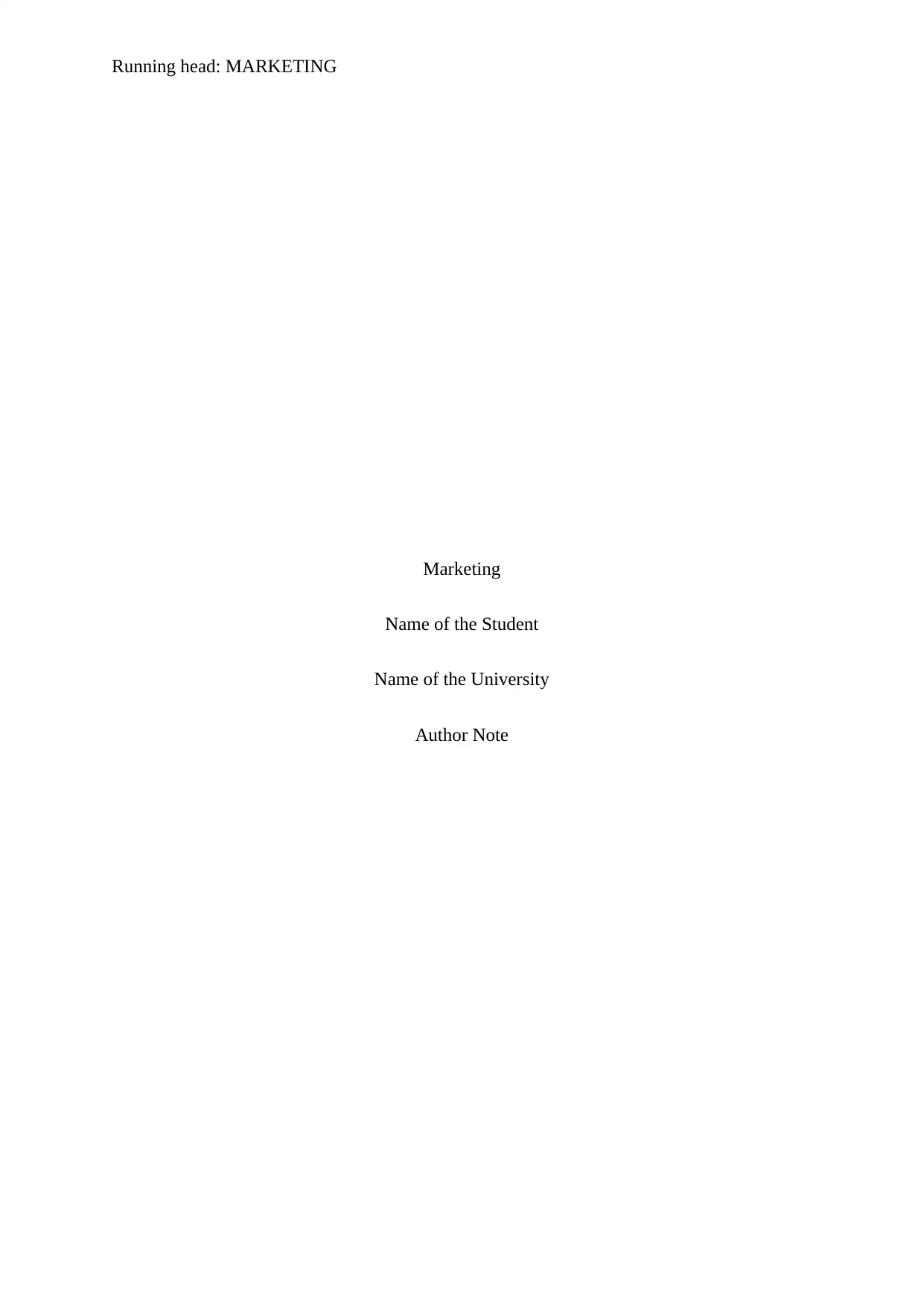
Running head: MARKETING
Marketing
Name of the Student
Name of the University
Author Note
Marketing
Name of the Student
Name of the University
Author Note
Paraphrase This Document
Need a fresh take? Get an instant paraphrase of this document with our AI Paraphraser
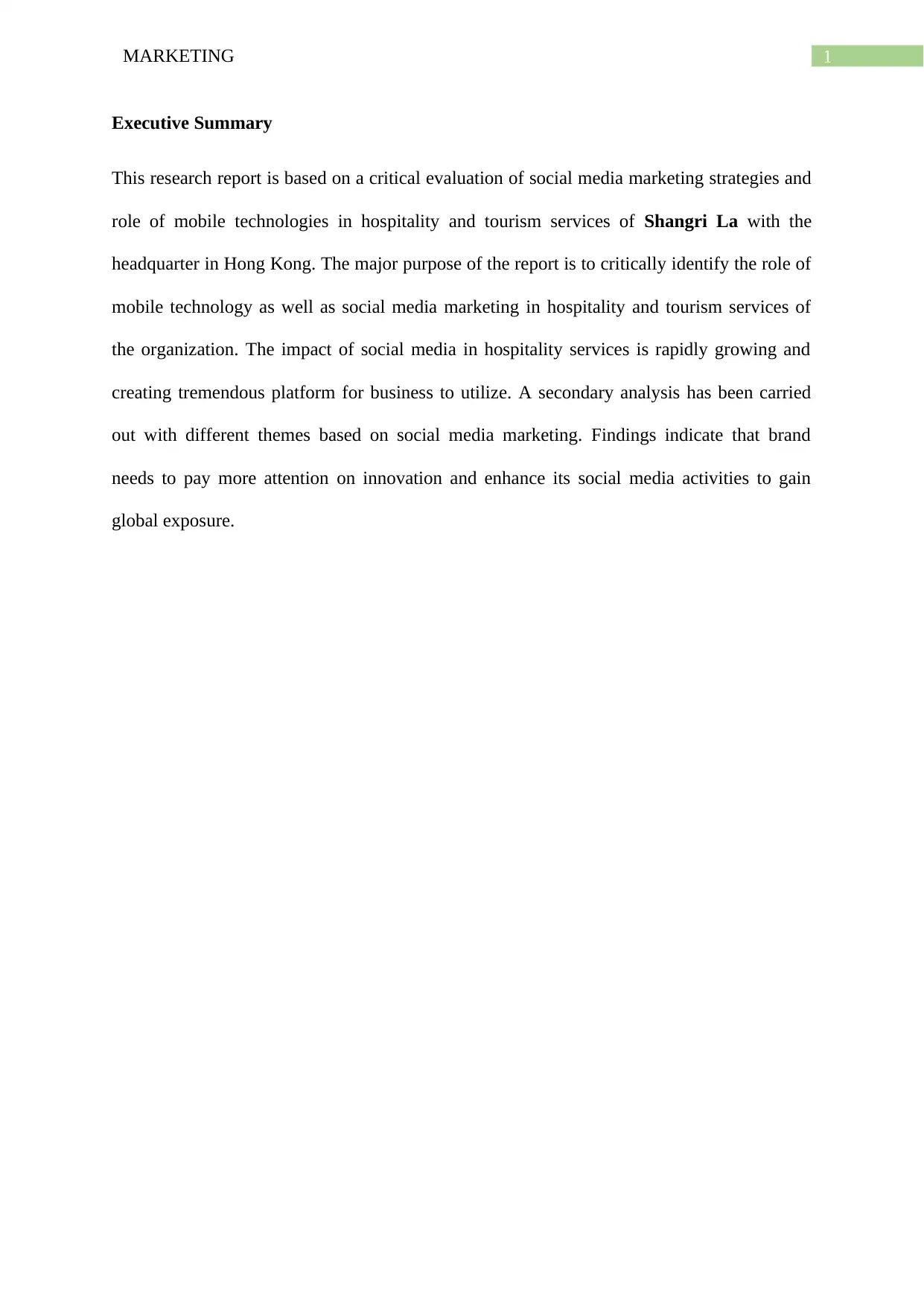
1MARKETING
Executive Summary
This research report is based on a critical evaluation of social media marketing strategies and
role of mobile technologies in hospitality and tourism services of Shangri La with the
headquarter in Hong Kong. The major purpose of the report is to critically identify the role of
mobile technology as well as social media marketing in hospitality and tourism services of
the organization. The impact of social media in hospitality services is rapidly growing and
creating tremendous platform for business to utilize. A secondary analysis has been carried
out with different themes based on social media marketing. Findings indicate that brand
needs to pay more attention on innovation and enhance its social media activities to gain
global exposure.
Executive Summary
This research report is based on a critical evaluation of social media marketing strategies and
role of mobile technologies in hospitality and tourism services of Shangri La with the
headquarter in Hong Kong. The major purpose of the report is to critically identify the role of
mobile technology as well as social media marketing in hospitality and tourism services of
the organization. The impact of social media in hospitality services is rapidly growing and
creating tremendous platform for business to utilize. A secondary analysis has been carried
out with different themes based on social media marketing. Findings indicate that brand
needs to pay more attention on innovation and enhance its social media activities to gain
global exposure.

2MARKETING
⊘ This is a preview!⊘
Do you want full access?
Subscribe today to unlock all pages.

Trusted by 1+ million students worldwide
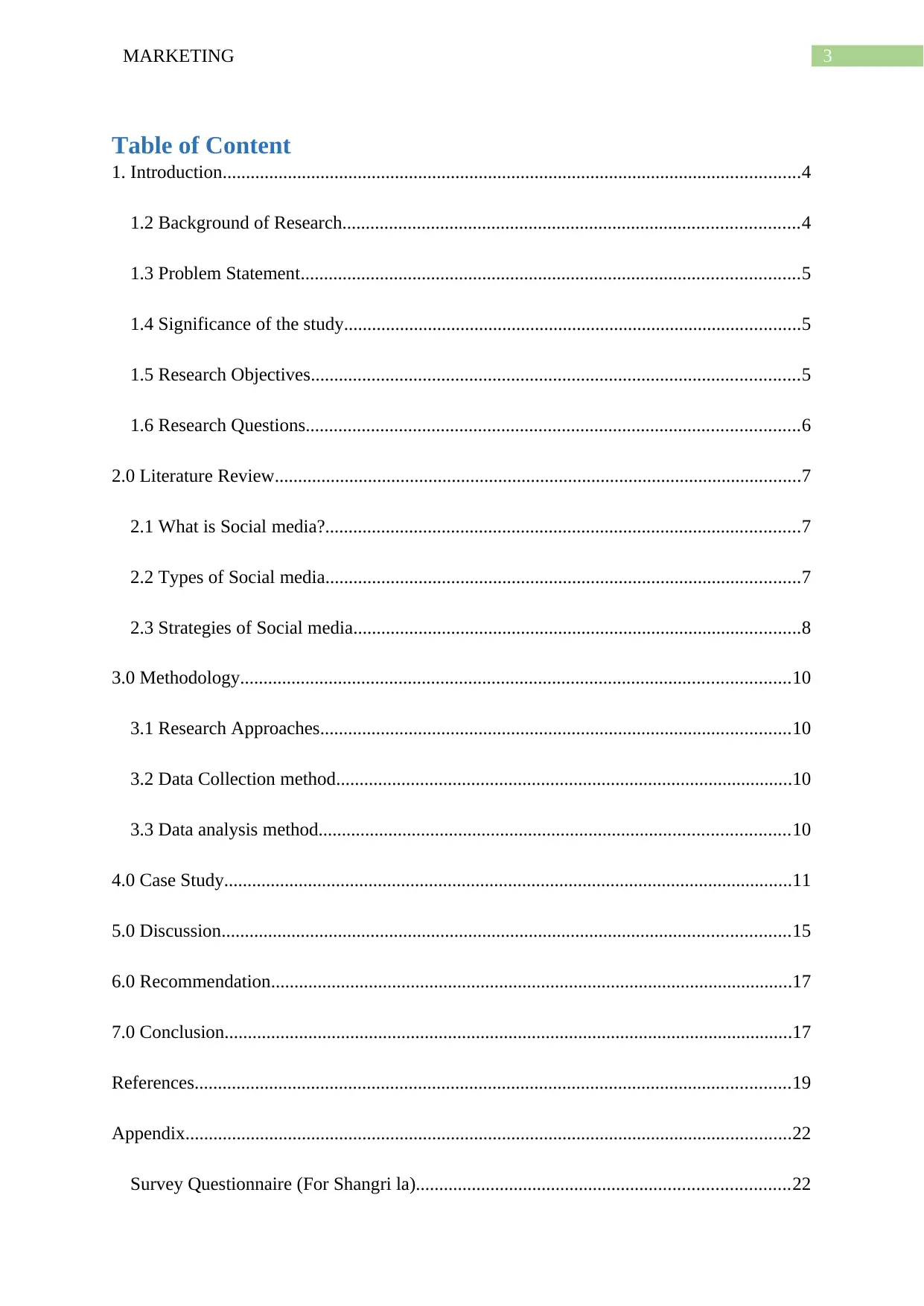
3MARKETING
Table of Content
1. Introduction............................................................................................................................4
1.2 Background of Research..................................................................................................4
1.3 Problem Statement...........................................................................................................5
1.4 Significance of the study..................................................................................................5
1.5 Research Objectives.........................................................................................................5
1.6 Research Questions..........................................................................................................6
2.0 Literature Review.................................................................................................................7
2.1 What is Social media?......................................................................................................7
2.2 Types of Social media......................................................................................................7
2.3 Strategies of Social media................................................................................................8
3.0 Methodology......................................................................................................................10
3.1 Research Approaches.....................................................................................................10
3.2 Data Collection method..................................................................................................10
3.3 Data analysis method.....................................................................................................10
4.0 Case Study..........................................................................................................................11
5.0 Discussion..........................................................................................................................15
6.0 Recommendation................................................................................................................17
7.0 Conclusion..........................................................................................................................17
References................................................................................................................................19
Appendix..................................................................................................................................22
Survey Questionnaire (For Shangri la)................................................................................22
Table of Content
1. Introduction............................................................................................................................4
1.2 Background of Research..................................................................................................4
1.3 Problem Statement...........................................................................................................5
1.4 Significance of the study..................................................................................................5
1.5 Research Objectives.........................................................................................................5
1.6 Research Questions..........................................................................................................6
2.0 Literature Review.................................................................................................................7
2.1 What is Social media?......................................................................................................7
2.2 Types of Social media......................................................................................................7
2.3 Strategies of Social media................................................................................................8
3.0 Methodology......................................................................................................................10
3.1 Research Approaches.....................................................................................................10
3.2 Data Collection method..................................................................................................10
3.3 Data analysis method.....................................................................................................10
4.0 Case Study..........................................................................................................................11
5.0 Discussion..........................................................................................................................15
6.0 Recommendation................................................................................................................17
7.0 Conclusion..........................................................................................................................17
References................................................................................................................................19
Appendix..................................................................................................................................22
Survey Questionnaire (For Shangri la)................................................................................22
Paraphrase This Document
Need a fresh take? Get an instant paraphrase of this document with our AI Paraphraser
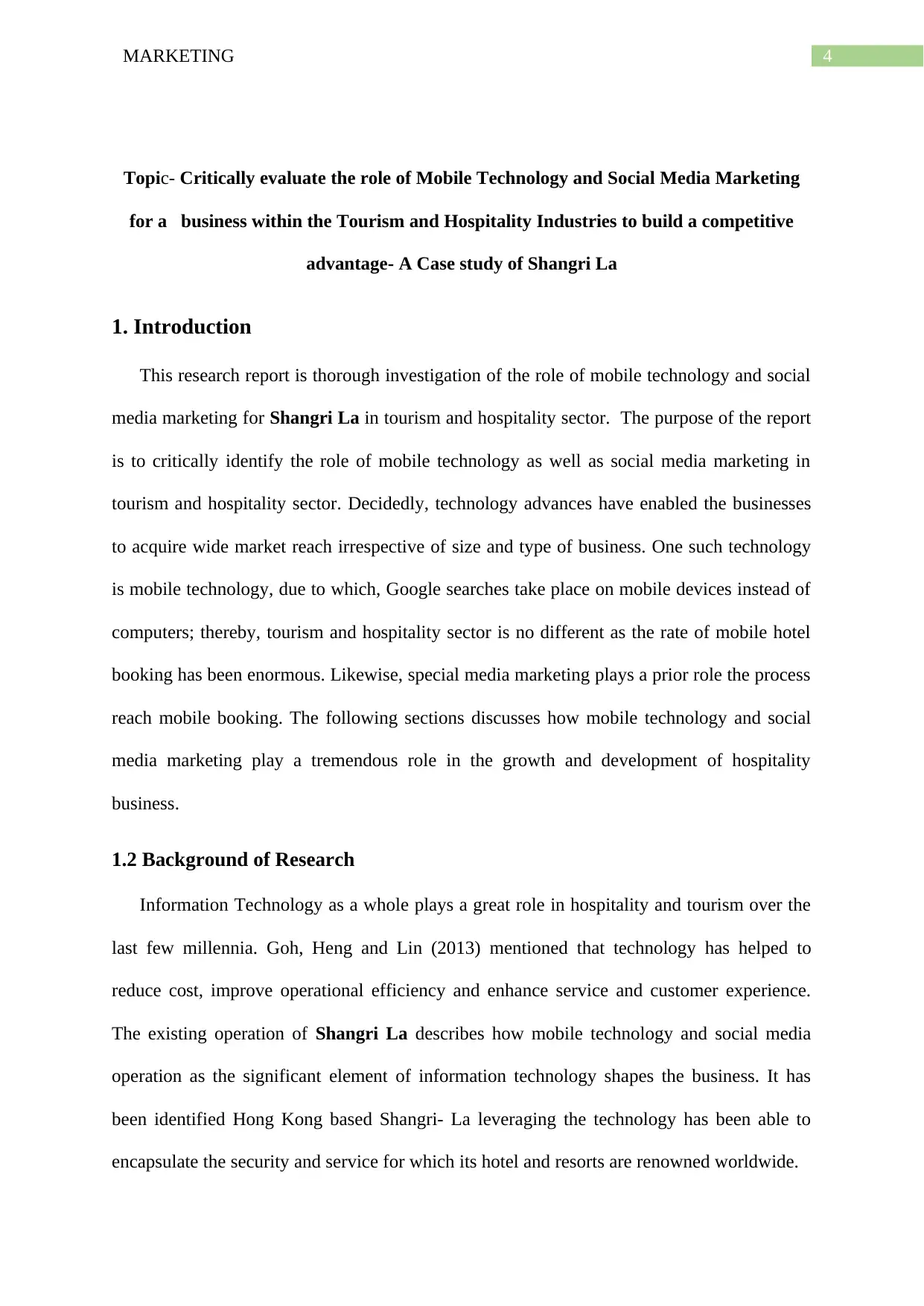
4MARKETING
Topic- Critically evaluate the role of Mobile Technology and Social Media Marketing
for a business within the Tourism and Hospitality Industries to build a competitive
advantage- A Case study of Shangri La
1. Introduction
This research report is thorough investigation of the role of mobile technology and social
media marketing for Shangri La in tourism and hospitality sector. The purpose of the report
is to critically identify the role of mobile technology as well as social media marketing in
tourism and hospitality sector. Decidedly, technology advances have enabled the businesses
to acquire wide market reach irrespective of size and type of business. One such technology
is mobile technology, due to which, Google searches take place on mobile devices instead of
computers; thereby, tourism and hospitality sector is no different as the rate of mobile hotel
booking has been enormous. Likewise, special media marketing plays a prior role the process
reach mobile booking. The following sections discusses how mobile technology and social
media marketing play a tremendous role in the growth and development of hospitality
business.
1.2 Background of Research
Information Technology as a whole plays a great role in hospitality and tourism over the
last few millennia. Goh, Heng and Lin (2013) mentioned that technology has helped to
reduce cost, improve operational efficiency and enhance service and customer experience.
The existing operation of Shangri La describes how mobile technology and social media
operation as the significant element of information technology shapes the business. It has
been identified Hong Kong based Shangri- La leveraging the technology has been able to
encapsulate the security and service for which its hotel and resorts are renowned worldwide.
Topic- Critically evaluate the role of Mobile Technology and Social Media Marketing
for a business within the Tourism and Hospitality Industries to build a competitive
advantage- A Case study of Shangri La
1. Introduction
This research report is thorough investigation of the role of mobile technology and social
media marketing for Shangri La in tourism and hospitality sector. The purpose of the report
is to critically identify the role of mobile technology as well as social media marketing in
tourism and hospitality sector. Decidedly, technology advances have enabled the businesses
to acquire wide market reach irrespective of size and type of business. One such technology
is mobile technology, due to which, Google searches take place on mobile devices instead of
computers; thereby, tourism and hospitality sector is no different as the rate of mobile hotel
booking has been enormous. Likewise, special media marketing plays a prior role the process
reach mobile booking. The following sections discusses how mobile technology and social
media marketing play a tremendous role in the growth and development of hospitality
business.
1.2 Background of Research
Information Technology as a whole plays a great role in hospitality and tourism over the
last few millennia. Goh, Heng and Lin (2013) mentioned that technology has helped to
reduce cost, improve operational efficiency and enhance service and customer experience.
The existing operation of Shangri La describes how mobile technology and social media
operation as the significant element of information technology shapes the business. It has
been identified Hong Kong based Shangri- La leveraging the technology has been able to
encapsulate the security and service for which its hotel and resorts are renowned worldwide.
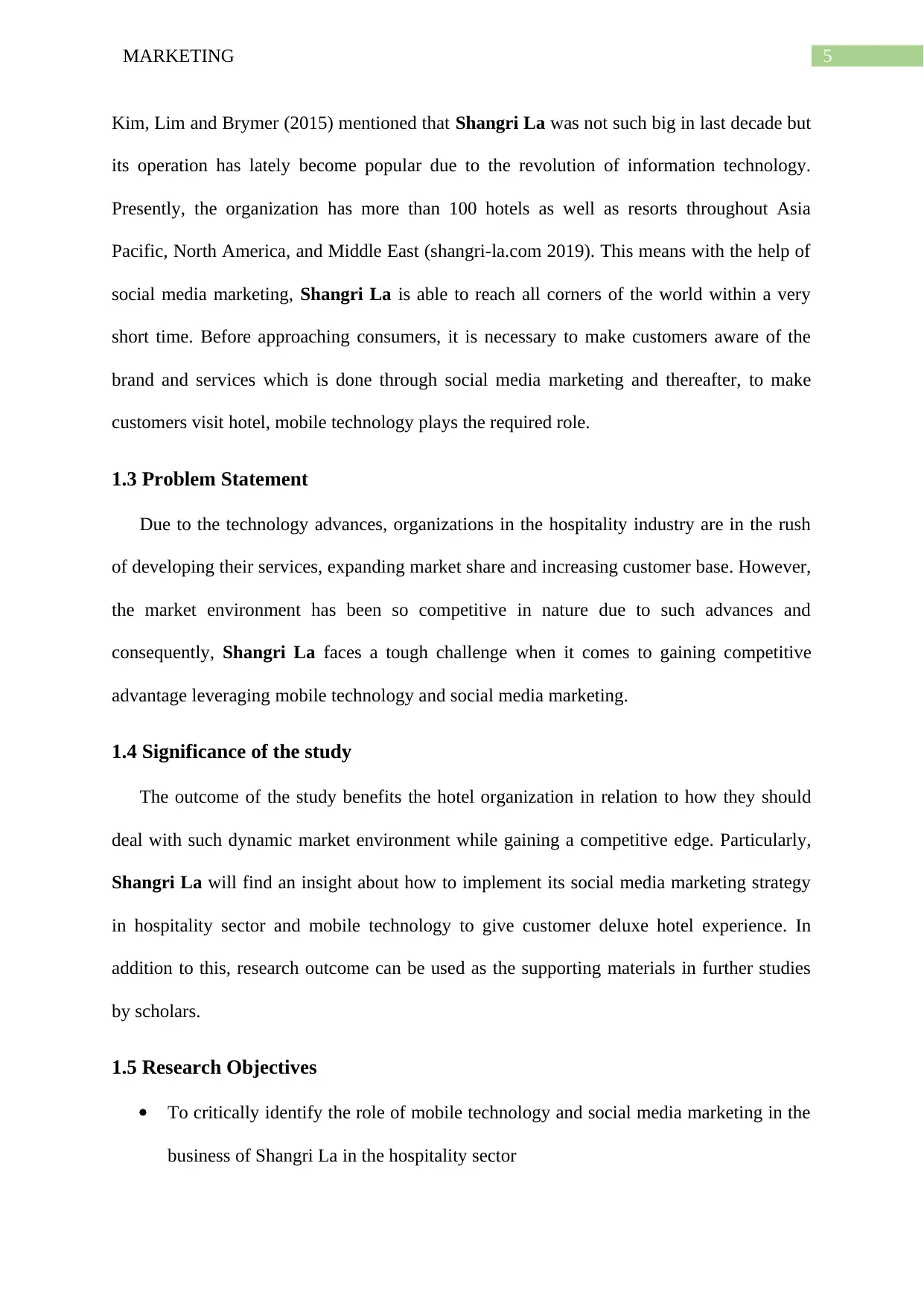
5MARKETING
Kim, Lim and Brymer (2015) mentioned that Shangri La was not such big in last decade but
its operation has lately become popular due to the revolution of information technology.
Presently, the organization has more than 100 hotels as well as resorts throughout Asia
Pacific, North America, and Middle East (shangri-la.com 2019). This means with the help of
social media marketing, Shangri La is able to reach all corners of the world within a very
short time. Before approaching consumers, it is necessary to make customers aware of the
brand and services which is done through social media marketing and thereafter, to make
customers visit hotel, mobile technology plays the required role.
1.3 Problem Statement
Due to the technology advances, organizations in the hospitality industry are in the rush
of developing their services, expanding market share and increasing customer base. However,
the market environment has been so competitive in nature due to such advances and
consequently, Shangri La faces a tough challenge when it comes to gaining competitive
advantage leveraging mobile technology and social media marketing.
1.4 Significance of the study
The outcome of the study benefits the hotel organization in relation to how they should
deal with such dynamic market environment while gaining a competitive edge. Particularly,
Shangri La will find an insight about how to implement its social media marketing strategy
in hospitality sector and mobile technology to give customer deluxe hotel experience. In
addition to this, research outcome can be used as the supporting materials in further studies
by scholars.
1.5 Research Objectives
To critically identify the role of mobile technology and social media marketing in the
business of Shangri La in the hospitality sector
Kim, Lim and Brymer (2015) mentioned that Shangri La was not such big in last decade but
its operation has lately become popular due to the revolution of information technology.
Presently, the organization has more than 100 hotels as well as resorts throughout Asia
Pacific, North America, and Middle East (shangri-la.com 2019). This means with the help of
social media marketing, Shangri La is able to reach all corners of the world within a very
short time. Before approaching consumers, it is necessary to make customers aware of the
brand and services which is done through social media marketing and thereafter, to make
customers visit hotel, mobile technology plays the required role.
1.3 Problem Statement
Due to the technology advances, organizations in the hospitality industry are in the rush
of developing their services, expanding market share and increasing customer base. However,
the market environment has been so competitive in nature due to such advances and
consequently, Shangri La faces a tough challenge when it comes to gaining competitive
advantage leveraging mobile technology and social media marketing.
1.4 Significance of the study
The outcome of the study benefits the hotel organization in relation to how they should
deal with such dynamic market environment while gaining a competitive edge. Particularly,
Shangri La will find an insight about how to implement its social media marketing strategy
in hospitality sector and mobile technology to give customer deluxe hotel experience. In
addition to this, research outcome can be used as the supporting materials in further studies
by scholars.
1.5 Research Objectives
To critically identify the role of mobile technology and social media marketing in the
business of Shangri La in the hospitality sector
⊘ This is a preview!⊘
Do you want full access?
Subscribe today to unlock all pages.

Trusted by 1+ million students worldwide
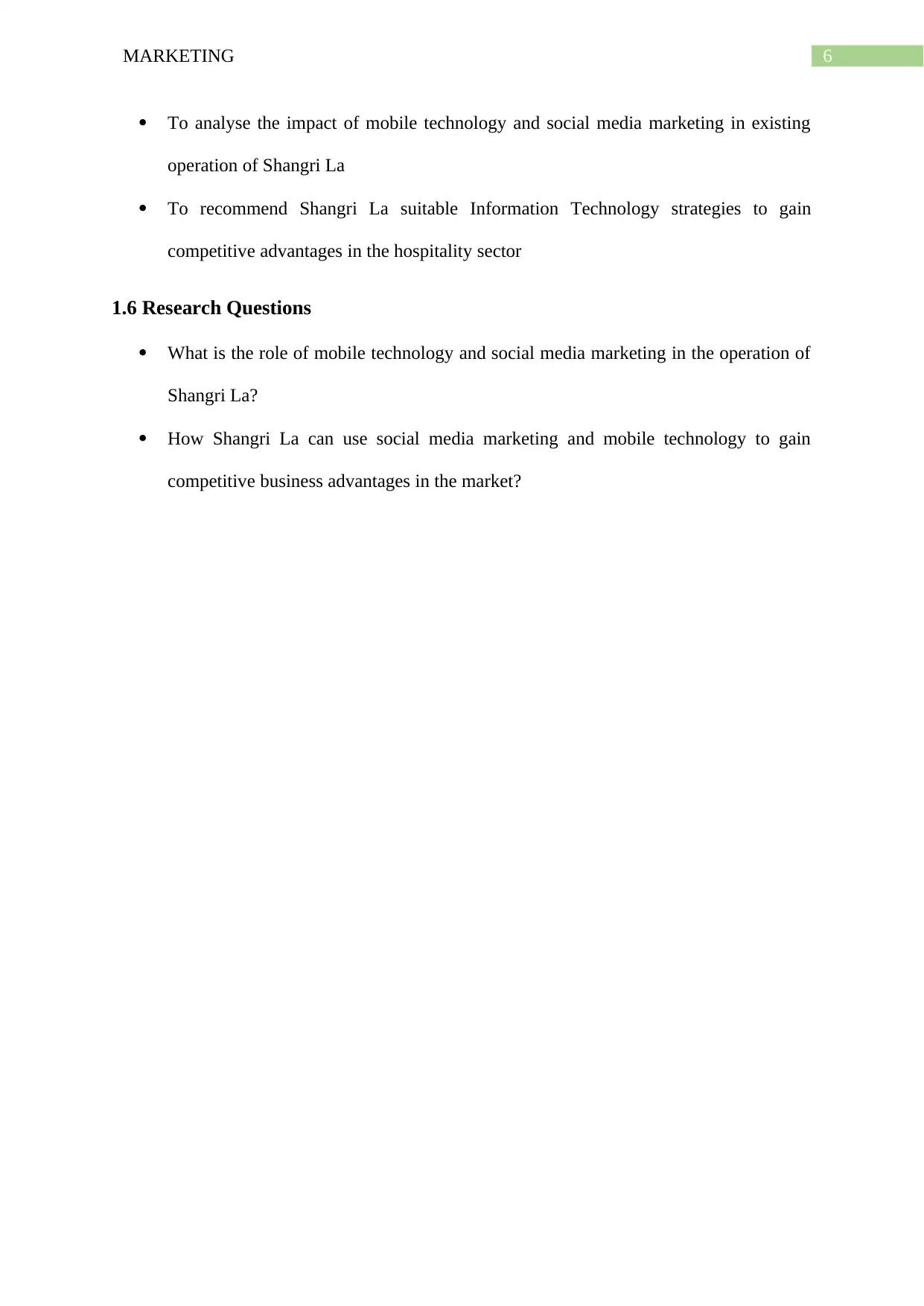
6MARKETING
To analyse the impact of mobile technology and social media marketing in existing
operation of Shangri La
To recommend Shangri La suitable Information Technology strategies to gain
competitive advantages in the hospitality sector
1.6 Research Questions
What is the role of mobile technology and social media marketing in the operation of
Shangri La?
How Shangri La can use social media marketing and mobile technology to gain
competitive business advantages in the market?
To analyse the impact of mobile technology and social media marketing in existing
operation of Shangri La
To recommend Shangri La suitable Information Technology strategies to gain
competitive advantages in the hospitality sector
1.6 Research Questions
What is the role of mobile technology and social media marketing in the operation of
Shangri La?
How Shangri La can use social media marketing and mobile technology to gain
competitive business advantages in the market?
Paraphrase This Document
Need a fresh take? Get an instant paraphrase of this document with our AI Paraphraser
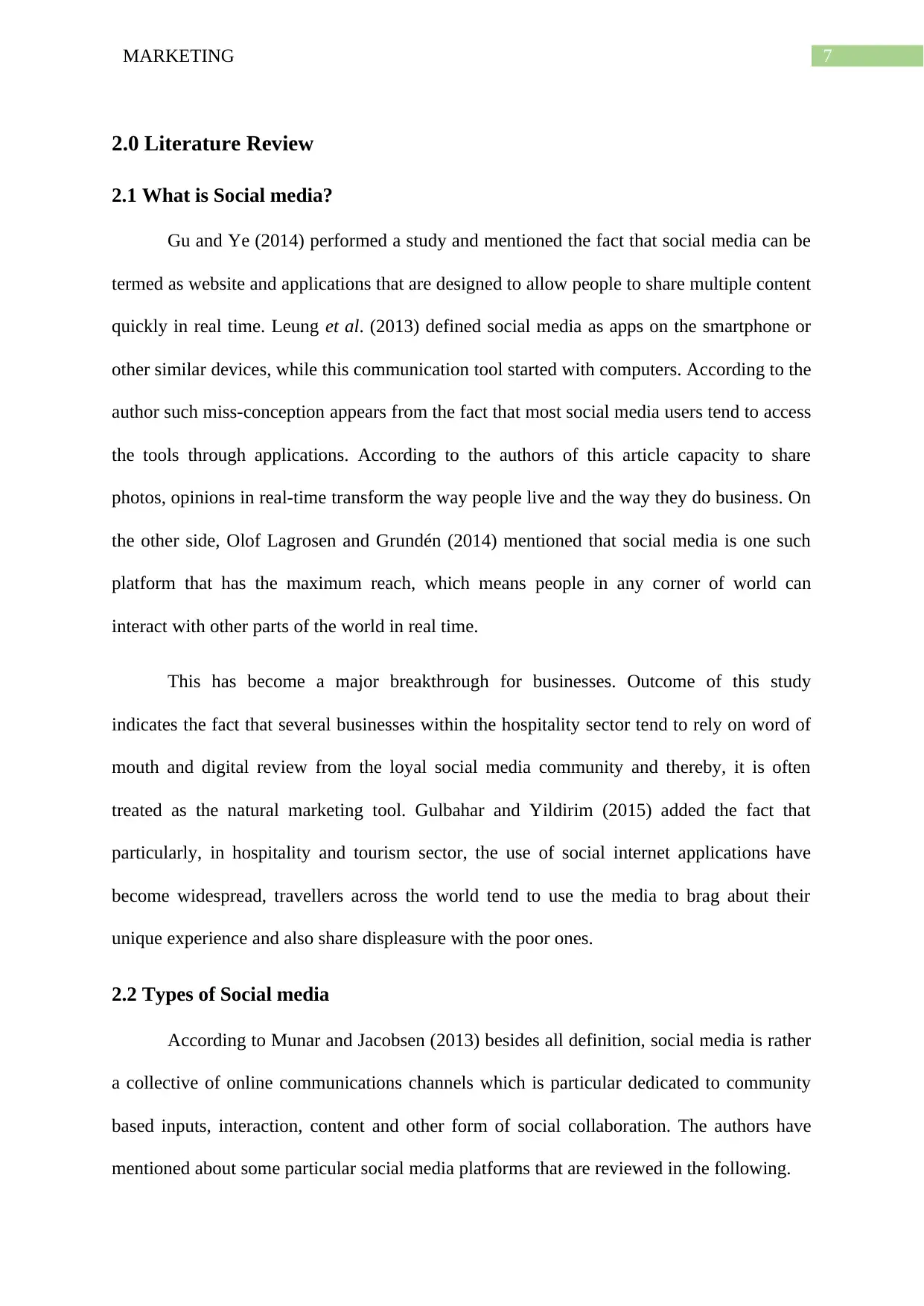
7MARKETING
2.0 Literature Review
2.1 What is Social media?
Gu and Ye (2014) performed a study and mentioned the fact that social media can be
termed as website and applications that are designed to allow people to share multiple content
quickly in real time. Leung et al. (2013) defined social media as apps on the smartphone or
other similar devices, while this communication tool started with computers. According to the
author such miss-conception appears from the fact that most social media users tend to access
the tools through applications. According to the authors of this article capacity to share
photos, opinions in real-time transform the way people live and the way they do business. On
the other side, Olof Lagrosen and Grundén (2014) mentioned that social media is one such
platform that has the maximum reach, which means people in any corner of world can
interact with other parts of the world in real time.
This has become a major breakthrough for businesses. Outcome of this study
indicates the fact that several businesses within the hospitality sector tend to rely on word of
mouth and digital review from the loyal social media community and thereby, it is often
treated as the natural marketing tool. Gulbahar and Yildirim (2015) added the fact that
particularly, in hospitality and tourism sector, the use of social internet applications have
become widespread, travellers across the world tend to use the media to brag about their
unique experience and also share displeasure with the poor ones.
2.2 Types of Social media
According to Munar and Jacobsen (2013) besides all definition, social media is rather
a collective of online communications channels which is particular dedicated to community
based inputs, interaction, content and other form of social collaboration. The authors have
mentioned about some particular social media platforms that are reviewed in the following.
2.0 Literature Review
2.1 What is Social media?
Gu and Ye (2014) performed a study and mentioned the fact that social media can be
termed as website and applications that are designed to allow people to share multiple content
quickly in real time. Leung et al. (2013) defined social media as apps on the smartphone or
other similar devices, while this communication tool started with computers. According to the
author such miss-conception appears from the fact that most social media users tend to access
the tools through applications. According to the authors of this article capacity to share
photos, opinions in real-time transform the way people live and the way they do business. On
the other side, Olof Lagrosen and Grundén (2014) mentioned that social media is one such
platform that has the maximum reach, which means people in any corner of world can
interact with other parts of the world in real time.
This has become a major breakthrough for businesses. Outcome of this study
indicates the fact that several businesses within the hospitality sector tend to rely on word of
mouth and digital review from the loyal social media community and thereby, it is often
treated as the natural marketing tool. Gulbahar and Yildirim (2015) added the fact that
particularly, in hospitality and tourism sector, the use of social internet applications have
become widespread, travellers across the world tend to use the media to brag about their
unique experience and also share displeasure with the poor ones.
2.2 Types of Social media
According to Munar and Jacobsen (2013) besides all definition, social media is rather
a collective of online communications channels which is particular dedicated to community
based inputs, interaction, content and other form of social collaboration. The authors have
mentioned about some particular social media platforms that are reviewed in the following.
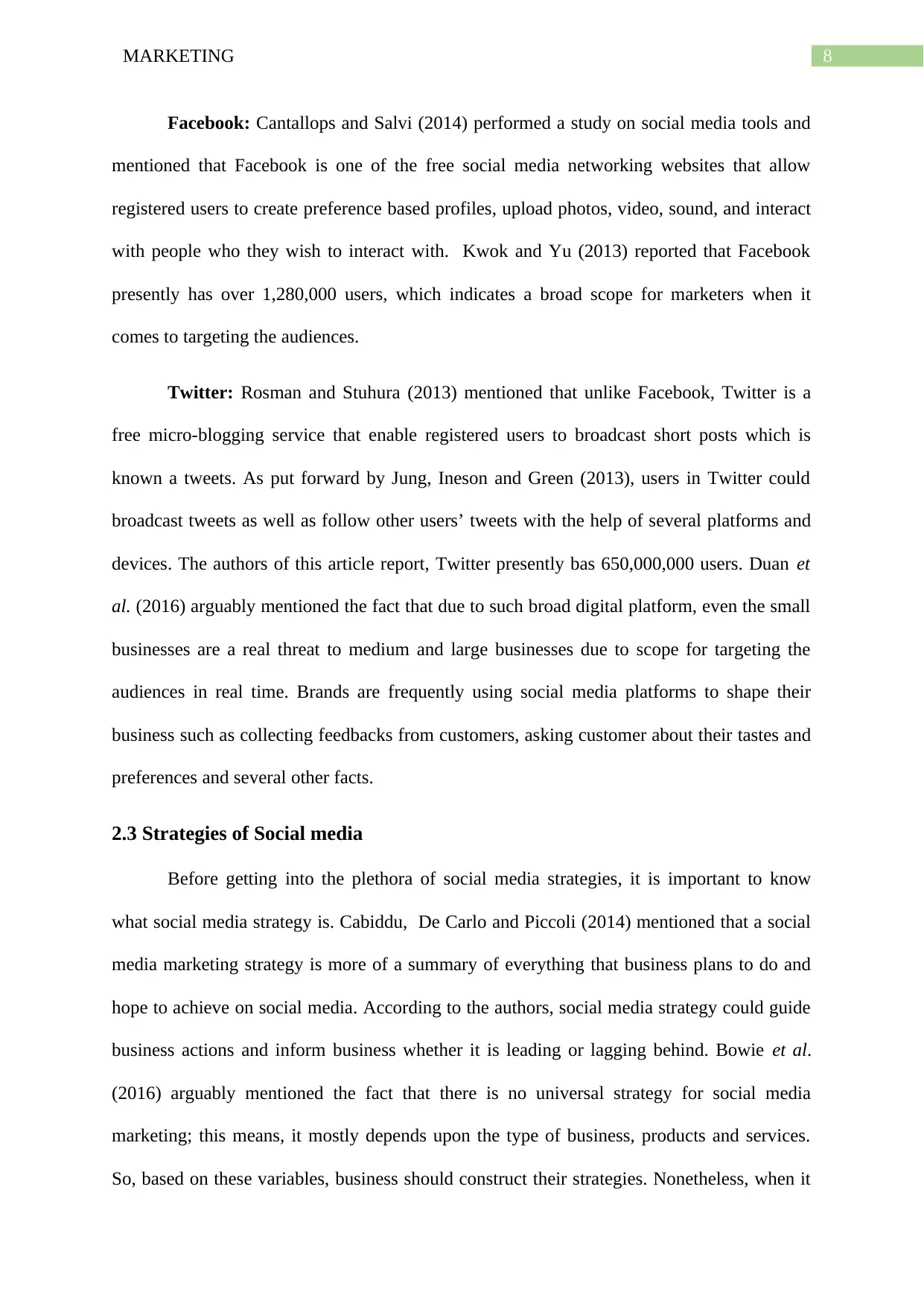
8MARKETING
Facebook: Cantallops and Salvi (2014) performed a study on social media tools and
mentioned that Facebook is one of the free social media networking websites that allow
registered users to create preference based profiles, upload photos, video, sound, and interact
with people who they wish to interact with. Kwok and Yu (2013) reported that Facebook
presently has over 1,280,000 users, which indicates a broad scope for marketers when it
comes to targeting the audiences.
Twitter: Rosman and Stuhura (2013) mentioned that unlike Facebook, Twitter is a
free micro-blogging service that enable registered users to broadcast short posts which is
known a tweets. As put forward by Jung, Ineson and Green (2013), users in Twitter could
broadcast tweets as well as follow other users’ tweets with the help of several platforms and
devices. The authors of this article report, Twitter presently bas 650,000,000 users. Duan et
al. (2016) arguably mentioned the fact that due to such broad digital platform, even the small
businesses are a real threat to medium and large businesses due to scope for targeting the
audiences in real time. Brands are frequently using social media platforms to shape their
business such as collecting feedbacks from customers, asking customer about their tastes and
preferences and several other facts.
2.3 Strategies of Social media
Before getting into the plethora of social media strategies, it is important to know
what social media strategy is. Cabiddu, De Carlo and Piccoli (2014) mentioned that a social
media marketing strategy is more of a summary of everything that business plans to do and
hope to achieve on social media. According to the authors, social media strategy could guide
business actions and inform business whether it is leading or lagging behind. Bowie et al.
(2016) arguably mentioned the fact that there is no universal strategy for social media
marketing; this means, it mostly depends upon the type of business, products and services.
So, based on these variables, business should construct their strategies. Nonetheless, when it
Facebook: Cantallops and Salvi (2014) performed a study on social media tools and
mentioned that Facebook is one of the free social media networking websites that allow
registered users to create preference based profiles, upload photos, video, sound, and interact
with people who they wish to interact with. Kwok and Yu (2013) reported that Facebook
presently has over 1,280,000 users, which indicates a broad scope for marketers when it
comes to targeting the audiences.
Twitter: Rosman and Stuhura (2013) mentioned that unlike Facebook, Twitter is a
free micro-blogging service that enable registered users to broadcast short posts which is
known a tweets. As put forward by Jung, Ineson and Green (2013), users in Twitter could
broadcast tweets as well as follow other users’ tweets with the help of several platforms and
devices. The authors of this article report, Twitter presently bas 650,000,000 users. Duan et
al. (2016) arguably mentioned the fact that due to such broad digital platform, even the small
businesses are a real threat to medium and large businesses due to scope for targeting the
audiences in real time. Brands are frequently using social media platforms to shape their
business such as collecting feedbacks from customers, asking customer about their tastes and
preferences and several other facts.
2.3 Strategies of Social media
Before getting into the plethora of social media strategies, it is important to know
what social media strategy is. Cabiddu, De Carlo and Piccoli (2014) mentioned that a social
media marketing strategy is more of a summary of everything that business plans to do and
hope to achieve on social media. According to the authors, social media strategy could guide
business actions and inform business whether it is leading or lagging behind. Bowie et al.
(2016) arguably mentioned the fact that there is no universal strategy for social media
marketing; this means, it mostly depends upon the type of business, products and services.
So, based on these variables, business should construct their strategies. Nonetheless, when it
⊘ This is a preview!⊘
Do you want full access?
Subscribe today to unlock all pages.

Trusted by 1+ million students worldwide
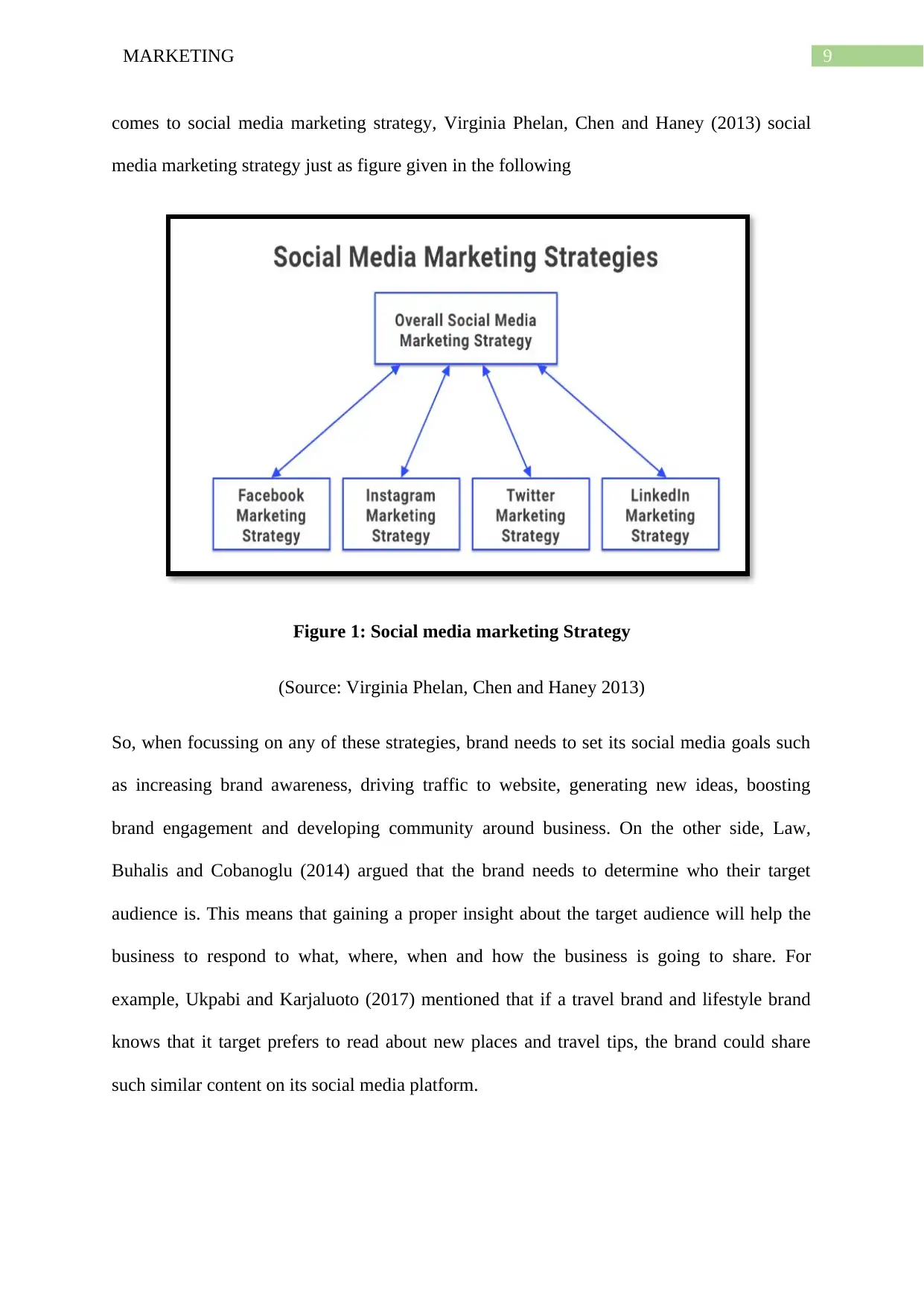
9MARKETING
comes to social media marketing strategy, Virginia Phelan, Chen and Haney (2013) social
media marketing strategy just as figure given in the following
Figure 1: Social media marketing Strategy
(Source: Virginia Phelan, Chen and Haney 2013)
So, when focussing on any of these strategies, brand needs to set its social media goals such
as increasing brand awareness, driving traffic to website, generating new ideas, boosting
brand engagement and developing community around business. On the other side, Law,
Buhalis and Cobanoglu (2014) argued that the brand needs to determine who their target
audience is. This means that gaining a proper insight about the target audience will help the
business to respond to what, where, when and how the business is going to share. For
example, Ukpabi and Karjaluoto (2017) mentioned that if a travel brand and lifestyle brand
knows that it target prefers to read about new places and travel tips, the brand could share
such similar content on its social media platform.
comes to social media marketing strategy, Virginia Phelan, Chen and Haney (2013) social
media marketing strategy just as figure given in the following
Figure 1: Social media marketing Strategy
(Source: Virginia Phelan, Chen and Haney 2013)
So, when focussing on any of these strategies, brand needs to set its social media goals such
as increasing brand awareness, driving traffic to website, generating new ideas, boosting
brand engagement and developing community around business. On the other side, Law,
Buhalis and Cobanoglu (2014) argued that the brand needs to determine who their target
audience is. This means that gaining a proper insight about the target audience will help the
business to respond to what, where, when and how the business is going to share. For
example, Ukpabi and Karjaluoto (2017) mentioned that if a travel brand and lifestyle brand
knows that it target prefers to read about new places and travel tips, the brand could share
such similar content on its social media platform.
Paraphrase This Document
Need a fresh take? Get an instant paraphrase of this document with our AI Paraphraser
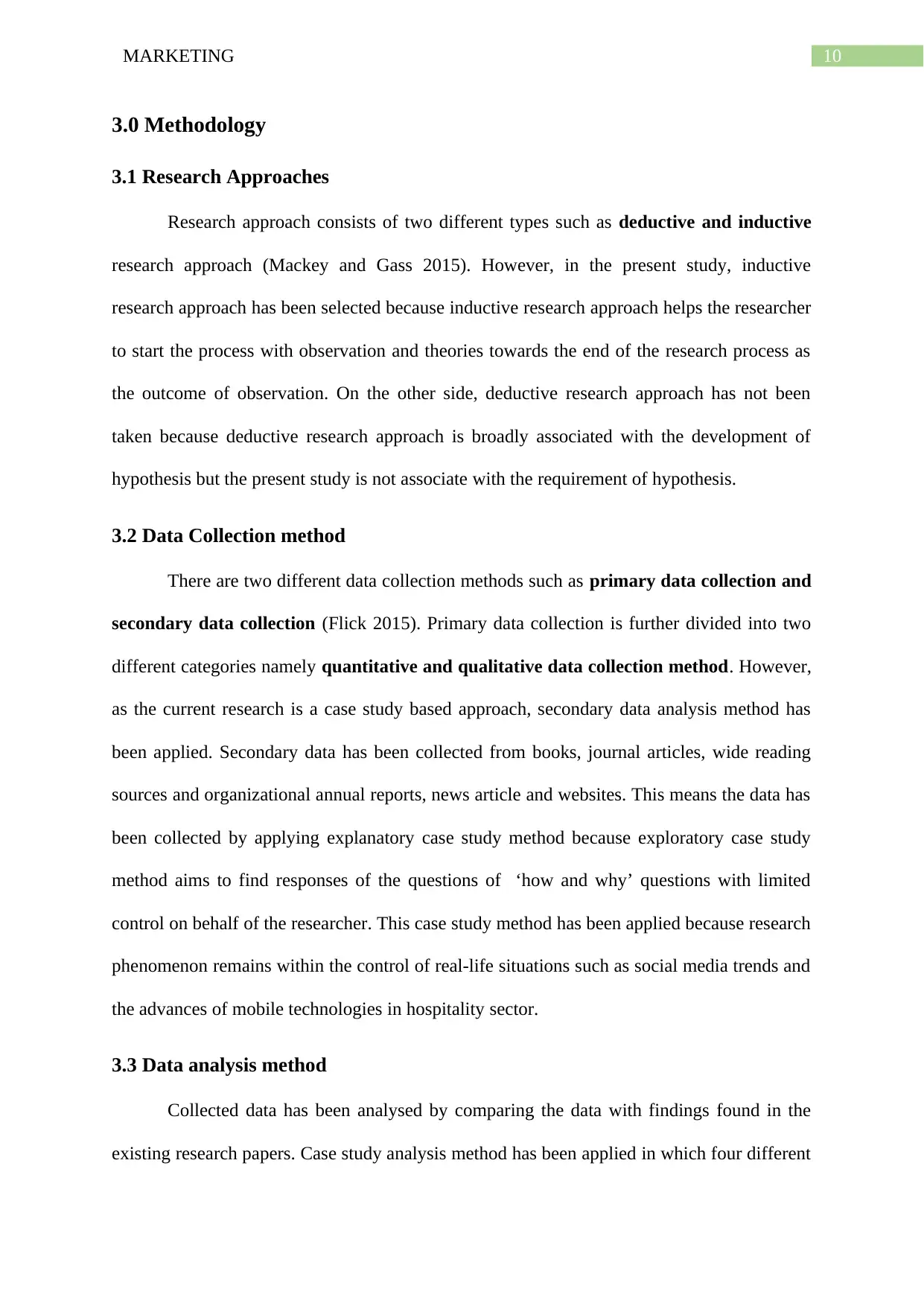
10MARKETING
3.0 Methodology
3.1 Research Approaches
Research approach consists of two different types such as deductive and inductive
research approach (Mackey and Gass 2015). However, in the present study, inductive
research approach has been selected because inductive research approach helps the researcher
to start the process with observation and theories towards the end of the research process as
the outcome of observation. On the other side, deductive research approach has not been
taken because deductive research approach is broadly associated with the development of
hypothesis but the present study is not associate with the requirement of hypothesis.
3.2 Data Collection method
There are two different data collection methods such as primary data collection and
secondary data collection (Flick 2015). Primary data collection is further divided into two
different categories namely quantitative and qualitative data collection method. However,
as the current research is a case study based approach, secondary data analysis method has
been applied. Secondary data has been collected from books, journal articles, wide reading
sources and organizational annual reports, news article and websites. This means the data has
been collected by applying explanatory case study method because exploratory case study
method aims to find responses of the questions of ‘how and why’ questions with limited
control on behalf of the researcher. This case study method has been applied because research
phenomenon remains within the control of real-life situations such as social media trends and
the advances of mobile technologies in hospitality sector.
3.3 Data analysis method
Collected data has been analysed by comparing the data with findings found in the
existing research papers. Case study analysis method has been applied in which four different
3.0 Methodology
3.1 Research Approaches
Research approach consists of two different types such as deductive and inductive
research approach (Mackey and Gass 2015). However, in the present study, inductive
research approach has been selected because inductive research approach helps the researcher
to start the process with observation and theories towards the end of the research process as
the outcome of observation. On the other side, deductive research approach has not been
taken because deductive research approach is broadly associated with the development of
hypothesis but the present study is not associate with the requirement of hypothesis.
3.2 Data Collection method
There are two different data collection methods such as primary data collection and
secondary data collection (Flick 2015). Primary data collection is further divided into two
different categories namely quantitative and qualitative data collection method. However,
as the current research is a case study based approach, secondary data analysis method has
been applied. Secondary data has been collected from books, journal articles, wide reading
sources and organizational annual reports, news article and websites. This means the data has
been collected by applying explanatory case study method because exploratory case study
method aims to find responses of the questions of ‘how and why’ questions with limited
control on behalf of the researcher. This case study method has been applied because research
phenomenon remains within the control of real-life situations such as social media trends and
the advances of mobile technologies in hospitality sector.
3.3 Data analysis method
Collected data has been analysed by comparing the data with findings found in the
existing research papers. Case study analysis method has been applied in which four different
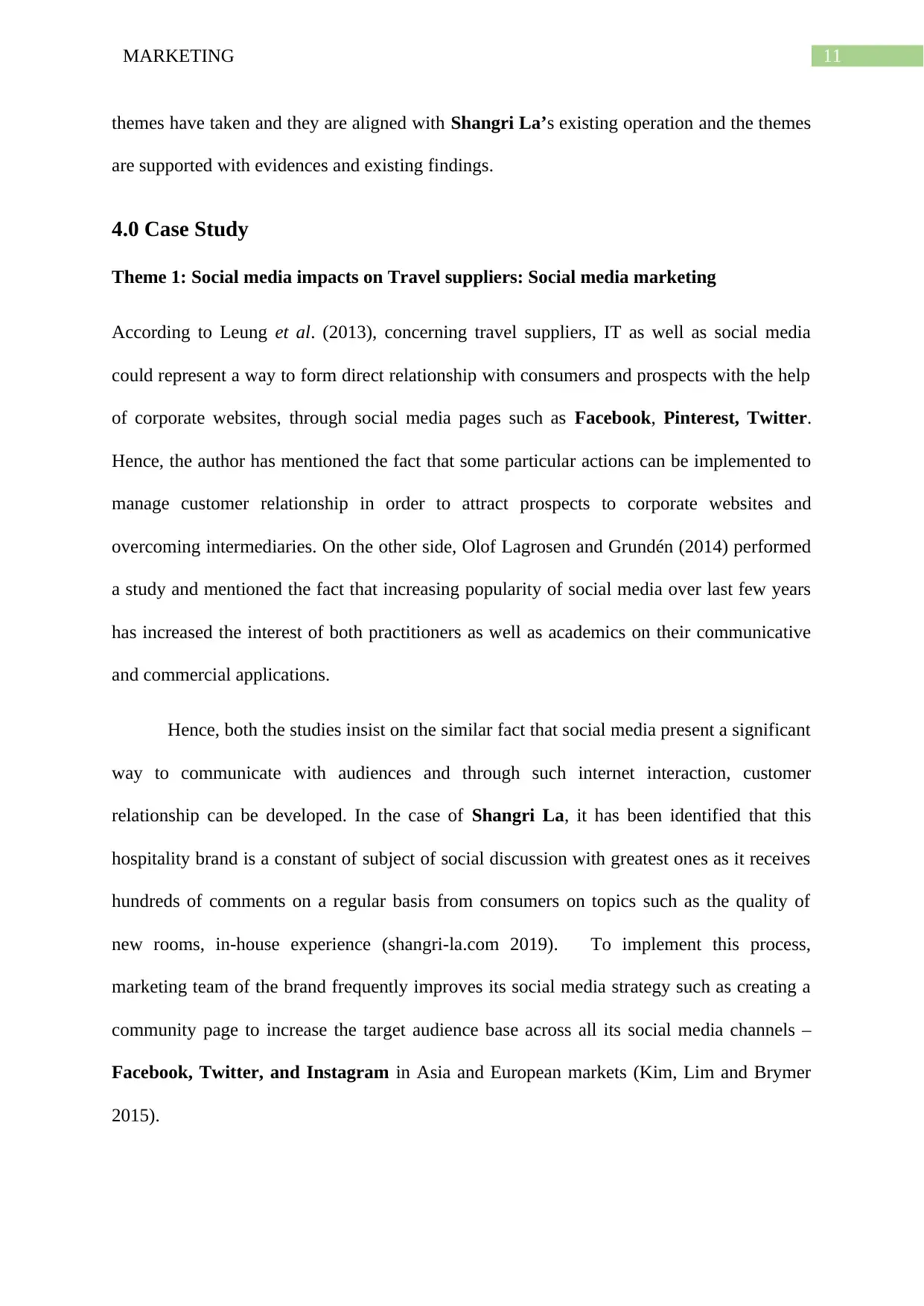
11MARKETING
themes have taken and they are aligned with Shangri La’s existing operation and the themes
are supported with evidences and existing findings.
4.0 Case Study
Theme 1: Social media impacts on Travel suppliers: Social media marketing
According to Leung et al. (2013), concerning travel suppliers, IT as well as social media
could represent a way to form direct relationship with consumers and prospects with the help
of corporate websites, through social media pages such as Facebook, Pinterest, Twitter.
Hence, the author has mentioned the fact that some particular actions can be implemented to
manage customer relationship in order to attract prospects to corporate websites and
overcoming intermediaries. On the other side, Olof Lagrosen and Grundén (2014) performed
a study and mentioned the fact that increasing popularity of social media over last few years
has increased the interest of both practitioners as well as academics on their communicative
and commercial applications.
Hence, both the studies insist on the similar fact that social media present a significant
way to communicate with audiences and through such internet interaction, customer
relationship can be developed. In the case of Shangri La, it has been identified that this
hospitality brand is a constant of subject of social discussion with greatest ones as it receives
hundreds of comments on a regular basis from consumers on topics such as the quality of
new rooms, in-house experience (shangri-la.com 2019). To implement this process,
marketing team of the brand frequently improves its social media strategy such as creating a
community page to increase the target audience base across all its social media channels –
Facebook, Twitter, and Instagram in Asia and European markets (Kim, Lim and Brymer
2015).
themes have taken and they are aligned with Shangri La’s existing operation and the themes
are supported with evidences and existing findings.
4.0 Case Study
Theme 1: Social media impacts on Travel suppliers: Social media marketing
According to Leung et al. (2013), concerning travel suppliers, IT as well as social media
could represent a way to form direct relationship with consumers and prospects with the help
of corporate websites, through social media pages such as Facebook, Pinterest, Twitter.
Hence, the author has mentioned the fact that some particular actions can be implemented to
manage customer relationship in order to attract prospects to corporate websites and
overcoming intermediaries. On the other side, Olof Lagrosen and Grundén (2014) performed
a study and mentioned the fact that increasing popularity of social media over last few years
has increased the interest of both practitioners as well as academics on their communicative
and commercial applications.
Hence, both the studies insist on the similar fact that social media present a significant
way to communicate with audiences and through such internet interaction, customer
relationship can be developed. In the case of Shangri La, it has been identified that this
hospitality brand is a constant of subject of social discussion with greatest ones as it receives
hundreds of comments on a regular basis from consumers on topics such as the quality of
new rooms, in-house experience (shangri-la.com 2019). To implement this process,
marketing team of the brand frequently improves its social media strategy such as creating a
community page to increase the target audience base across all its social media channels –
Facebook, Twitter, and Instagram in Asia and European markets (Kim, Lim and Brymer
2015).
⊘ This is a preview!⊘
Do you want full access?
Subscribe today to unlock all pages.

Trusted by 1+ million students worldwide
1 out of 25
Related Documents
Your All-in-One AI-Powered Toolkit for Academic Success.
+13062052269
info@desklib.com
Available 24*7 on WhatsApp / Email
![[object Object]](/_next/static/media/star-bottom.7253800d.svg)
Unlock your academic potential
Copyright © 2020–2025 A2Z Services. All Rights Reserved. Developed and managed by ZUCOL.




